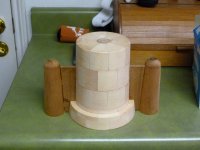I don't know how it compared to the Ford V8 or the Lincoln but the most demanding casting project I've ever seen undertaken by an engine restorer was the aluminum Rolls Royce head for the Phantom I. These are a notable weak point in the design although it's one that didn't show up until the cars were probably 50 years old and it is lagely attributable to the alloys that were available in 1929 and later owners — when they were just "used cars" — using the wrong types of anti freeze. The late Frank Cooke succeeded in making a run of PI heads but it was a long slog...they lost about 1 in 3 in the machining, sometimes when they were nearly done, from flaws in the casting that were invisible at first. Even 40 years ago a new head cost about $10,000. They have been successfully replicated more recently but the cost is 2 or 3 times that now. Lately, I've been wondering about the feasibility of using 3D printed sand molds for these small run, highly specialized castings. I probably won't live long enough to experiment with it but I suspect that technology will make complicated, one off castings far more affordable.







